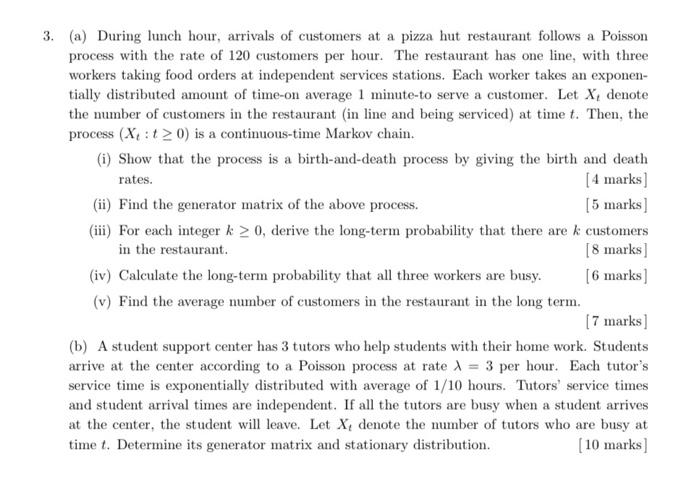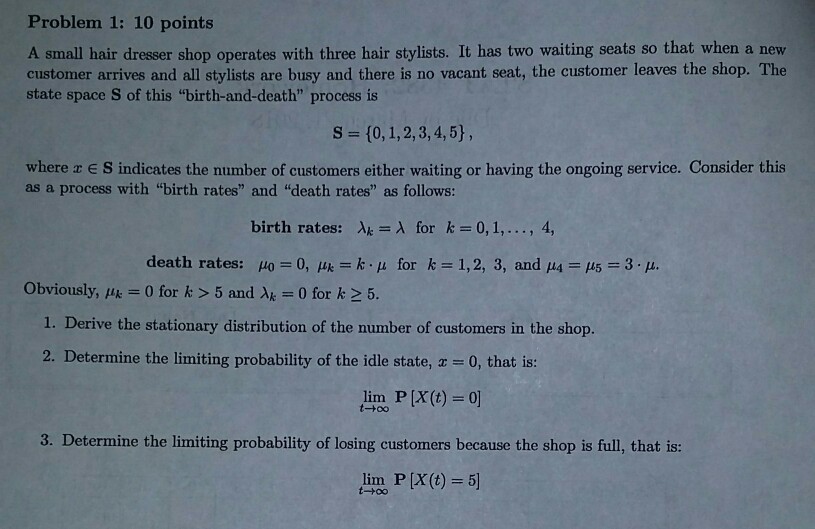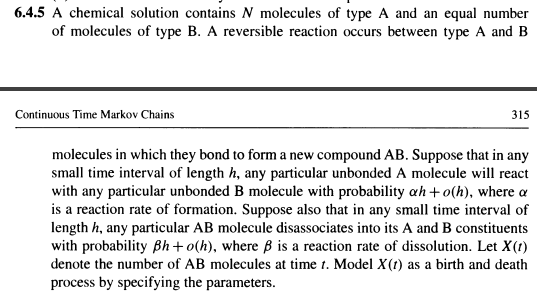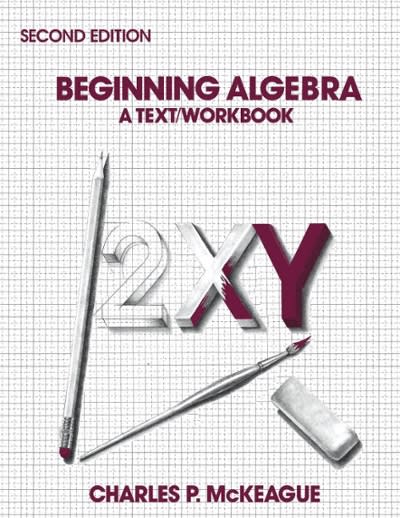3. (a) During lunch hour, arrivals of customers at a pizza hut restaurant follows a Poisson process with the rate of 120 customers per hour. The restaurant has one line, with three workers taking food orders at independent services stations. Each worker takes an exponen- tially distributed amount of time-on average 1 minute-to serve a customer. Let X, denote the number of customers in the restaurant (in line and being serviced) at time t. Then, the process (Xt : 1 2 0) is a continuous-time Markov chain. (i) Show that the process is a birth-and-death process by giving the birth and death rates. [4 marks] (ii) Find the generator matrix of the above process. [5 marks] (iii) For each integer & 2 0, derive the long-term probability that there are & customers in the restaurant. [8 marks] (iv) Calculate the long-term probability that all three workers are busy. [6 marks] (v) Find the average number of customers in the restaurant in the long term. [7 marks ] (b) A student support center has 3 tutors who help students with their home work. Students arrive at the center according to a Poisson process at rate A = 3 per hour. Each tutor's service time is exponentially distributed with average of 1/10 hours. Tutors' service times and student arrival times are independent. If all the tutors are busy when a student arrives at the center, the student will leave. Let X, denote the number of tutors who are busy at time t. Determine its generator matrix and stationary distribution. [10 marks]Problem 1: 10 points A small hair dresser shop operates with three hair stylists. It has two waiting seats so that when a new customer arrives and all stylists are busy and there is no vacant seat, the customer leaves the shop. The state space S of this "birth-and-death" process is S = {0, 1, 2, 3, 4, 5} , where a E S indicates the number of customers either waiting or having the ongoing service. Consider this as a process with "birth rates" and "death rates" as follows: birth rates: Ak = A for k = 0, 1, ..., 4, death rates: /0 = 0, #x = k . u for k = 1, 2, 3, and #4 = 45 = 3 . H. Obviously, /k = 0 for k > 5 and Ak = 0 for k 2 5. 1. Derive the stationary distribution of the number of customers in the shop. 2. Determine the limiting probability of the idle state, x = 0, that is: lim P [X(t) = 0] 1 -+ 0o 3. Determine the limiting probability of losing customers because the shop is full, that is: lim P [X(t) = 5] 1-too1. [10pt] Let b E RP be a vector and E E RPXP be a positive definite matrix. Let X be a p-dimensional random vector with the density function f(x) = Cexp (b/ x - }x" E lx) xERP, where C > 0 is a constant. Find the mean vector and variance-covariance matrix of X. Hint: X follows a multivariate normal distribution.]6.4.5 A chemical solution contains A molecules of type A and an equal number of molecules of type B. A reversible reaction occurs between type A and B Continuous Time Markov Chains 315 molecules in which they bond to form a new compound AB. Suppose that in any small time interval of length h, any particular unbonded A molecule will react with any particular unbonded B molecule with probability ah + o(h), where a is a reaction rate of formation. Suppose also that in any small time interval of length /, any particular AB molecule disassociates into its A and B constituents with probability Bh + o(h), where B is a reaction rate of dissolution. Let X(1) denote the number of AB molecules at time r. Model X(/) as a birth and death process by specifying the parameters










